Pricing Guides & Dictionary of Makers Marks for Antiques & Collectibles

IMARI & ARITA PORCELAIN:
Imari Patterns from Japan and China
Join the most updated and complete collectibles research online - Learn more...
 IMARI actually refers to the port of Imari in Japan, from where Japanese Porcelain chinaware from the nearby city of ARITA were shipped to mostly European destinations since early 18thC. For this reason, Imari now stands for a distinct decorative style developed and perfected by several companies & potteries or artisans in this region in the form of Decorative & Art Porcelain or Earthenware.
IMARI actually refers to the port of Imari in Japan, from where Japanese Porcelain chinaware from the nearby city of ARITA were shipped to mostly European destinations since early 18thC. For this reason, Imari now stands for a distinct decorative style developed and perfected by several companies & potteries or artisans in this region in the form of Decorative & Art Porcelain or Earthenware.
The Imari decorative style originally consisted mainly of symmetric geometric panels with elegant repeating or slightly varied patterns of floral motifs and was characterized by a very specific combination of colors, primarily strong greens, and dark reds, most often underglaze, and called ARITA WARE. As this style became more popular, especially in Western markets, dark blue and bright gold coloring was added to the mix and has remained the most dominant variation since then. This newer style is also referred to as KINRANDE by serious collectors to distinguish it from the older patterns. Needless to say, as porcelain manufacturing became more established in Europe, the Imari style and patterns were extensively imitated and almost blatantly copied by several companies in the UK, Germany, Holland, and France. The KAKIEMON style is similar to IMARI, but with more white spaces and thinly decorated surfaces.
Original Arita & Imari kilns date as early as the 1610s, established by mostly Korean potters brought in to help in developing the local Ceramics industry and used local high-quality white clay. Their efforts flourished around 80 to 100 years later and local potteries became extremely versed in the art of porcelain, producing remarkably beautiful and sturdy items. It is said that the original influences on the Imari style were from Dutch traders, who requested that Arita potters use familiar patterns and designs found on local textiles that seemed exotic and more appealing at the time to European buyers. These authentic early 18thC Imari patterns, now found in Museums and very fine private collections, were somewhat "busy" and had no gold overtones or overglaze gilding. However, the vast majority of items found in the market today with an ARITA or IMARI label or in that style date ca mid-19thC onwards and may originate from many countries other than Japan.
Chinese porcelain makers also imitated and soon adopted this style and began making CHINESE IMARI in slight variations, mainly in the selection of colors and some of the floral designs.
Unlock the true value of your collection with our comprehensive research guides from identifying makers' marks to appraising all kinds of antiques and collectibles, including items featured in this article.
Our up-to-date information will give you an accurate understanding of your items' worth. Don't miss out on this valuable resource - visit our research tools today!
In addition to some examples shown below on this page, you can also search our price guide for your own treasures.
Examples of related items from our Price Guides
-
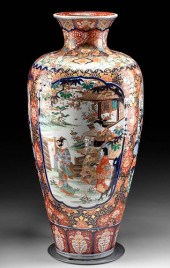 HUGE 19TH C. JAPANESE IMARI VASE - GARDE
[more like this]
HUGE 19TH C. JAPANESE IMARI VASE - GARDE
[more like this]
-
 LARGE COLLECTION OF JAPANESE PORCELAINS.
[more like this]
LARGE COLLECTION OF JAPANESE PORCELAINS.
[more like this]
-
 ASSEMBLED GROUP OF ENGLISH PORCELAIN IMA
[more like this]
ASSEMBLED GROUP OF ENGLISH PORCELAIN IMA
[more like this]
-
 26 PC ROYAL CROWN DERBY IMARI PLATES, TR
[more like this]
26 PC ROYAL CROWN DERBY IMARI PLATES, TR
[more like this]
-
 FOUR BOXES OF BOOKS ON JAPANESE AND THEA
[more like this]
FOUR BOXES OF BOOKS ON JAPANESE AND THEA
[more like this]
-
 Group of thirty seven Chinese and Japane
[more like this]
Group of thirty seven Chinese and Japane
[more like this]
-
![[JAPANESE ART—REFERENCE]
A co](/images/japanese-art-reference-a-collection-of--34d514-medium.jpg) [JAPANESE ART—REFERENCE]
A collection o
[more like this]
[JAPANESE ART—REFERENCE]
A collection o
[more like this]
-
 THREE BOXES OF JAPANESE PRINT AND PAINTI
[more like this]
THREE BOXES OF JAPANESE PRINT AND PAINTI
[more like this]
-
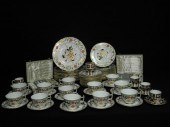 Royal Crown Derby porcelain dinnerware 7
[more like this]
Royal Crown Derby porcelain dinnerware 7
[more like this]
-
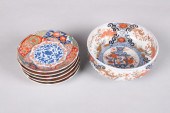 SET OF FIVE JAPANESE IMARI DISHES IN SIG
[more like this]
SET OF FIVE JAPANESE IMARI DISHES IN SIG
[more like this]
-
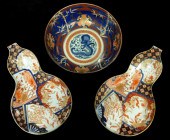 ASIAN: PAIR OF JAPANESE IMARI PORCELAIN
[more like this]
ASIAN: PAIR OF JAPANESE IMARI PORCELAIN
[more like this]
-
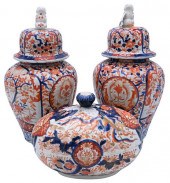 THREE JAPANESE IMARI PORCELAIN PIECESThr
[more like this]
THREE JAPANESE IMARI PORCELAIN PIECESThr
[more like this]
There are many more auction results available to our members...





